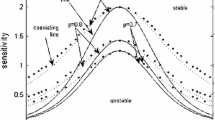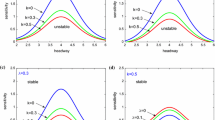Abstract
By introducing optimal velocity car-following model by Bando et al., we present an improved car-following model which is based on an optimal velocity model considering traffic jerk and full velocity difference. The nature of the model is researched by using linear and nonlinear analysis method. The analytical method and numerical simulation results show that the proposed model can describe the phase transition and critical phenomenon with the thermodynamic theory. In order to describe the traffic flow near the critical point, the time-dependent Ginzburg–Landau (TDGL) equation and the modified Korteweg–de Vries (mKdV) equation are derived. Additionally, the connection between the TDGL and the mKdV equation is also given. Theoretical analysis is demonstrated by numerical simulation.



Similar content being viewed by others
References
Tang, T.Q., Huang, H.J., Zhao, S.G., Shang, H.Y.: A new dynamic model for heterogeneous traffic flow. Phys. Lett. A 373, 2461–2466 (2009)
Ge, H.X., Zheng, P.J., Lo, S.M., Cheng, R.J.: TDGL equation in lattice hydrodynamic model considering driver’s physical delay. Nonlinear Dyn. 76, 441–445 (2014)
Tang, T.Q., Li, C.Y., Wu, Y.H., Huang, H.J.: Impact of the honk effect on the stability of traffic flow. Phys. A 390, 3362–3368 (2011)
Peng, G.H., Song, W., Peng, Y.J., Wang, S.H.: A novel macro model of traffic flow with the consideration of anticipation optimal velocity. Phys. A 398, 76–82 (2014)
Tang, T.Q., He, J., Wu, Y.H., Caccetta, L.: Propagating properties of traffic flow on a ring road without ramp. Phys. A 396, 164–172 (2014)
Moussa, N., Daoudia, A.K.: Numerical study of two classes of cellular automaton models for traffic flow on a two-lane roadway. Eur. Phys. B 31, 413–420 (2003)
Tang, C.F., Jiang, R., Wu, Q.S., Wiwatanapataphee, B., Wu, Y.H.: Mixed traffic flow in anisotropic continuum model. Transp. Res. Rec. 1999, 13–22 (2007)
Sun, D.H., Zhang, M., Chuan, T.: Multiple optimal current difference effect in the lattice traffic flow model. Mod. Phys. Lett. B 28, 1450091 (2014)
Helbing, D., Tilch, B.: Generalized force model of traffic dynamics. Phys. Rev. E 58, 133–138 (1998)
Zhu, H.B., Dai, S.Q.: Numerical simulation of soliton and kink density waves in traffic flow with periodic boundaries. Phys. A 387, 16–17 (2008)
Li, Z.P., Gong, X.B., Liu, Y.C.: An improved car-following model for multiphase vehicular traffic flow and numerical tests. Commun. Theor. Phys. 46, 367–73 (2006)
Jiang, R., Hu, M.B., Zhang, H.M., Gao, Z.Y., Jia, B., Wu, Q.S., Wang, B., Yang, M.: Traffic experiment reveals the nature of car-following. PLoS One 9, 4 (2014)
Jiang, R., Hu, M.B., Zhang, H.M., Gao, Z.Y., Jia, B., Wu, Q.S.: On some experimental features of car-following behavior and how to model them. Transp. Rese. Part. B 80, 338–354 (2015)
Tang, T.Q., Li, P., Yang, X.B.: An extended macro model for traffic flow with consideration of multi static bottlenecks. Phys. A 392, 3537–3545 (2013)
Zhu, W.X., Zhang, L.D.: Analysis of car-following model with cascade compensation strategy. Phys. A 449, 265–274 (2016)
Helbing, D.: Derivation of non-local macroscopic traffic equations and consistent traffic pressures from microscopic car-following models. Phys. J. B 69, 539–548 (2009)
Xue, Y.: Analysis of the stability and density waves for traffic flow. Chin. Phys. 11, 1128–1134 (2002)
Peng, G.H., Cai, X.H., Liu, C.Q., Cao, B.F., Tuo, M.X.: Optimal velocity difference model for a car-following theory. Phys. Lett. A 375, 3973–3977 (2011)
Peng, G.H., Cai, X.H., Cao, B.F., Liu, C.Q.: A new lattice model of traffic flow with the consideration of the traffic interruption probability. Phys. A 391, 656–663 (2012)
Li, Y.F., Sun, D.H., Liu, W.N., Zhang, M., Zhao, M., Liao, X.Y., Tang, L.: Modeling and simulation for microscopic traffic flow based on multiple headway, velocity and acceleration difference. Nonlinear Dyn. 66, 15–28 (2011)
Ye, J.J., Li, K.P., Jin, X.M.: Simulating train movement in an urban railway based on an improved car-following model. Chin. Phys. B 22, 120206 (2013)
Tang, T.Q., Huang, H.J., Gao, Z.Y., Wong, S.C.: Interactions of waves in the speed-gradient traffic flow model. Phys. A 380, 481–489 (2007)
Tang, T.Q., Wu, Y.H., Caccetta, L., Huang, H.J.: A new car-following model with consideration of roadside memorial. Phys. Lett. A 375, 3845–3850 (2011)
Ge, H.X., Dai, S.Q., Xue, Y., Dong, L.Y.: Stabilization analysis and modified Korteweg–de Vries equation in a cooperative driving system. Phys. Rev. E 71, 066119 (2005)
Qian, Y.S., Shao, X.M., Zeng, J.W., Wang, M.: An improved cellular automaton model with the consideration of a multi-point tollbooth. Phys. A 392, 5874–5878 (2013)
Li, L., Wang, F., Jiang, R., Hu, J.M., Ji, Y.: A new car-following model yielding log-normal type headways distributions. Phys. B 19, 020513 (2010)
Nagatani, T.: TDGL and mKdV equation for jamming transition in the lattice models of traffic. Phys. A 264, 581–592 (1999)
Nagatani, T.: Thermodynamic theory for the jamming transition in traffic flow. Phys. Rev. E 58, 4271–4276 (1998)
Nagatani, T.: Jamming transition in the lattice models of traffic. Phys. Rev. E 59, 4857–4864 (1999)
Peng, G.H., Cai, X.H., Liu, C.Q., Tuo, M.X.: A new lattice model of traffic flow with the anticipation effect of potential lane changing. Phys. Lett. A 376, 447–451 (2012)
Ge, H.X., Cheng, R.J., Lo, S.M.: Time-dependent Ginzburglandau equation for lattice hydrodynamic model describing pedestrian flow. Chin. Phys. B 22, 070507 (2013)
Li, Z.P., Liu, F.Q., Sun, J.: A lattice traffic model with consideration of preceding mixture traffic information. Chin. Phys. B 20, 088901 (2011)
Lv, F., Zhu, H.B., Ge, H.X.: TDGL and mKdV equations for car-following model considering driver’s anticipation. Nonlinear Dyn. 77, 1245–1250 (2014)
Nagatani, T.: Modified KdV equation for jamming transition in the continuum models of traffic. Phys. A 261, 599–607 (1998)
Zhou, J., Shi, Z.K.: A new lattice hydrodynamic model for bidirectional pedestrian flow with the consideration of pedestrian’s anticipation effect. Nonlinear Dyn. 81, 1247–1262 (2015)
Tian, H.H., Hu, H.D., Wei, Y.F., Xue, Y., Lu, W.Z.: Lattice hydrodynamic model with bidirectional pedestrian flow. Phys. A 388, 2895–2902 (2009)
Bando, M., Haseba, K., Nakayama, A., Shibata, A., Sugiyama, Y.: Dynamical model of traffic congestion and numerical simulation. Phys. Rev. E 51, 1035–1042 (1995)
Helbing, D., Tilch, B.: Generalized force model of traffic dynamic. Phys. Rev. E 58, 133–138 (1998)
Jiang, R., Wu, Q.S., Zhu, Z.J.: Full velocity difference model for a car-following theory. Phys. Rev. E 64, 017101 (2001)
Ge, H.X., Cheng, R.J., Li, Z.P.: Two velocity difference model for a car following theory. Phys. A 387, 5239–5245 (2008)
Peng, G.H.: A study of wide moving jams in a new lattice model of traffic flow with the consideration of the driver anticipation effect and numerical simulation. Phys. A 391, 5971–5977 (2012)
Yang, S.C., Li, M., Tang, T.Q.: An electric vehicle’s battery life model under car-following model. Measurement 46, 4226–4231 (2013)
Tang, T.Q., Shi, W.F., Yang, X.B., Wang, Y.P., Lu, G.Q.: A macro traffic flow model accounting for road capacity and reliability analysis. Phys. A 392, 6300–6306 (2013)
Liu, F.X., Cheng, R.J., Zheng, P.J., Ge, H.X.: TDGL and mKdV equations for car-following model considering traffic jerk. Nonlinear Dyn. 83, 793–800 (2015)
Acknowledgments
This work was supported by the National Natural Science Foundation of China (Grant No. 11372166), the Scientific Research Fund of Zhejiang Provincial, China (Grant Nos. LY15A020007, LY15E080013), the Natural Science Foundation of Ningbo (Grant Nos. 2014A610028, 2014A610022) and the K. C. Wong Magna Fund in Ningbo University, China.
Author information
Authors and Affiliations
Corresponding author
Rights and permissions
About this article
Cite this article
Song, H., Ge, H., Chen, F. et al. TDGL and mKdV equations for car-following model considering traffic jerk and velocity difference. Nonlinear Dyn 87, 1809–1817 (2017). https://doi.org/10.1007/s11071-016-3154-x
Received:
Accepted:
Published:
Issue Date:
DOI: https://doi.org/10.1007/s11071-016-3154-x




